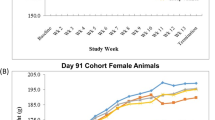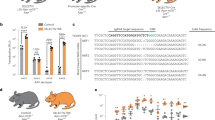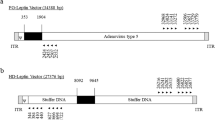Abstract
Recombinant adenoviral vectors are broadly applied in gene therapy protocols. However, adenovector-mediated gene transfer has limitations in vivo. One of these is the low gene transfer rate into organs other than the liver after systemic intravenous vector injection. Local direct injection into the target organ has been used as one possible solution, but increases necessary equipment and methodology and is traumatic to the target. Wild-type adenovirus infection as well as adenovector-mediated gene transfer depends on virus interaction with the Coxsackie adenovirus receptor (CAR) mediating virus attachment to the cell surface, and on interaction with αvβ3 and αvβ5 integrins mediating virus entry into the cell. In order to assess the receptor-associated potential of different tissues to act as adenovector targets, we have therefore determined CAR and αv-integrin expression in multiple organs from different species. In addition, we have newly determined several human, rat, pig and dog CAR-mRNA sequences. Sequence comparison and structural analyses of known and of newly determined sequences suggests a potential adenovirus binding site between amino acids 29 and 128 of the CAR. With respect to the virus receptor expression patterns we found that CAR-mRNA expression was extremely variable between different tissues, with the highest levels in the liver, whereas αv-integrin expression was far more homogenous among different organs. Both CAR and αv-integrin showed similar expression patterns among different species. There was no correlation, however, between the adenovector expression patterns after intravenous, intracardiac and aortic root injection, respectively, and the virus receptor patterns. In summary, many organs carry both receptors required to make them potential adenovector targets. In sharp contrast, their actual targeting clearly indicates that adenovirus receptor expression is necessary but not sufficient for vector transfer after systemic injection. The apparently very important role of anatomical barriers, in particular the endothelium, requires close attention when developing non-traumatic, organ-specific gene therapy protocols.
This is a preview of subscription content, access via your institution
Access options
Subscribe to this journal
Receive 12 print issues and online access
$259.00 per year
only $21.58 per issue
Buy this article
- Purchase on Springer Link
- Instant access to full article PDF
Prices may be subject to local taxes which are calculated during checkout











Similar content being viewed by others
References
Merrick AF et al. Comparison of adenovirus gene transfer to vascular endothelial cells in cell culture, organ culture, and in vivo Transplantation 1996 62: 1085–1089
Benhamou PY et al. Adenovirus-mediated catalase gene transfer reduces oxidant stress in human, porcine and rat pancreatic islets Diabetologia 1998 41: 1093–1100
Pickles RJ et al. Limited entry of adenovirus vectors into well-differentiated airway epithelium is responsible for inefficient gene transfer J Virol 1998 72: 6014–6023
Tsubota K et al. Adenovirus-mediated gene transfer to the ocular surface epithelium (in process citation) Exp Eye Res 1998 67: 531–538
Crystal RG et al. Administration of an adenovirus containing the human CFTR cDNA to the respiratory tract of individuals with cystic fibrosis (see comments) Nat Genet 1994 8: 42–51
Yukawa H et al. In vitro growth suppression of vascular smooth muscle cells using adenovirus-mediated gene transfer of a truncated form of fibroblast growth factor receptor Atherosclerosis 1998 141: 125–132
Hidaka C et al. CAR-dependent and CAR-independent pathways of adenovirus vector-mediated gene transfer and expression in human fibroblasts J Clin Invest 1999 103: 579–587
Davidson BL et al. A model system for in vivo gene transfer into the central nervous system using an adenoviral vector (see comments) Nat Genet 1993 3: 219–223
Roessler BJ et al. Adenoviral-mediated gene transfer to rabbit synovium in vivo J Clin Invest 1993 92: 1085–1092
Raphael Y, Frisancho JC, Roessler BJ . Adenoviral-mediated gene transfer into guinea pig cochlear cells in vivo Neurosci Lett 1996 207: 137–141
Chauvet AE, Kesava PP, Goh CS, Badie B . Selective intraarterial gene delivery into a canine meningioma J Neurosurg 1998 88: 870–873
Howell JM et al. High-level dystrophin expression after adenovirus-mediated dystrophin minigene transfer to skeletal muscle of dystrophic dogs: prolongation of expression with immunosuppression Hum Gene Ther 1998 9: 629–634
Shears LL 2nd et al. Efficient inhibition of intimal hyperplasia by adenovirus-mediated inducible nitric oxide synthase gene transfer to rats and pigs in vivo J Am Coll Surg 1998 187: 295–306
Mondain M et al. Adenovirus-mediated in vivo gene transfer in guinea pig middle ear mucosa Hum Gene Ther 1998 9: 1217–1221
Torres JM et al. Tropism of human adenovirus type 5-based vectors in swine and their ability to protect against transmissible gastroenteritis coronavirus J Virol 1996 70: 3770–3780
Kass-Eisler A et al. The impact of developmental stage, route of administration and the immune system on adenovirus-mediated gene transfer Gene Therapy 1994 1: 395–402
Acsadi G et al. Dystrophin expression in muscles of mdx mice after adenovirus-mediated in vivo gene transfer Hum Gene Ther 1996 7: 129–140
Christenson SD et al. Adenovirus-mediated gene transfer in vivo to cerebral blood vessels and perivascular tissue in mice Stroke 1998 29: 1411–5; discussion 1416
Leon RP et al. Adenoviral-mediated gene transfer in lymphocytes Proc Natl Acad Sci USA 1998 95: 13159–13164
Suzuki M et al. Similarity of strain- and route-dependent murine responses to an adenovirus vector using the homologous thrombopoietin cDNA as the reporter genes Hum Gene Ther 1998 9: 1223–1231
Haase G et al. Adenovirus-mediated transfer of the neurotrophin-3 gene into skeletal muscle of pmn mice: therapeutic effects and mechanisms of action (in process citation) J Neurol Sci 1998 160 (Suppl. 1): S97–105
Franz WM, Rothmann T, Frey N, Katus HA . Analysis of tissue-specific gene delivery by recombinant adenoviruses containing cardiac-specific promoters Cardiovasc Res 1997 35: 560–566
Rothmann T et al. Heart muscle-specific gene expression using replication defective recombinant adenovirus Gene Therapy 1996 3: 919–926
Hajjar RJ et al. Modulation of ventricular function through gene transfer in vivo Proc Natl Acad Sci USA 1998 95: 5251–5256
Rekhter MD et al. Graft permeabilization facilitates gene therapy of transplant arteriosclerosis in a rabbit model Circulation 1998 98: 1335–1341
Rekhter MD et al. Gene transfer into normal and atherosclerotic human blood vessels (see comments) Circ Res 1998 82: 1243–1252
Kaplan JM et al. Potentiation of gene transfer to the mouse lung by complexes of adenovirus vector and polycations improves therapeutic potential Hum Gene Ther 1998 9: 1469–1479
Lisby DA et al. Enhanced distribution of adenovirus-mediated gene transfer to lung parenchyma by perfluorochemical liquid Hum Gene Ther 1997 8: 919–928
Ghodsi A et al. Extensive beta-glucuronidase activity in murine central nervous system after adenovirus-mediated gene transfer to brain Hum Gene Ther 1998 9: 2331–2340
Foreman PK et al. Adenovirus-mediated transduction of intestinal cells in vivo Hum Gene Ther 1998 9: 1313–1321
DeMatteo RP et al. Gene transfer to the thymus. A means of abrogating the immune response to recombinant adenovirus Ann Surg 1995 222: 229–239; discussion 239–344
Anglade E, Csaky KG . Recombinant adenovirus-mediated gene transfer into the adult rat retina Curr Eye Res 1998 17: 316–321
Delporte C, Redman RS, Baum BJ . Relationship between the cellular distribution of the alpha(v)beta3/5 integrins and adenoviral infection in salivary glands Lab Invest 1997 77: 167–173
Grubb BR et al. Inefficient gene transfer by adenovirus vector to cystic fibrosis airway epithelia of mice and humans Nature 1994 371: 802–806
Goldman MJ, Wilson JM . Expression of αvβ5 integrin is necessary for efficient adenovirus-mediated gene transfer in the human airway J Virol 1995 69: 5951–5958
Huang S, Endo RI, Nemerow GR . Upregulation of integrins αvβ3 and αvβ5 on human monocytes and T lymphocytes facilitates adenovirus-mediated gene delivery J Virol 1995 69: 2257–2263
Bergelson JM et al. The murine CAR homolog is a receptor for coxsackie B viruses and adenoviruses J Virol 1998 72: 415–419
Bergelson JM et al. Isolation of a common receptor for Coxsackie B viruses and adenoviruses 2 and 5 Science 1997 275: 1320–1323
Tomko RP, Xu R, Philipson L . HCAR and MCAR: the human and mouse cellular receptors for subgroup C adenoviruses and group B coxsackieviruses Proc Natl Acad Sci USA 1997 94: 3352–3356
Wickham TJ, Mathias P, Cheresh DA, Nemerow GR . Integrins αvβ3 and αvβ5 promote adenovirus internalization but not virus attachment Cell 1993 73: 309–319
Wickham TJ, Filardo EJ, Cheresh DA, Nemerow GR . Integrin αvβ5 selectively promotes adenovirus mediated cell membrane permeabilization J Cell Biol 1994 127: 257–264
Mathias P, Galleno M, Nemerow GR . Interactions of soluble recombinant integrin αvβ5 with human adenoviruses J Virol 1998 72: 8669–8675
Greber UF, Willetts M, Webster P, Helenius A . Stepwise dismantling of adenovirus 2 during entry into cells Cell 1993 75: 477–486
Chretien I et al. CTX, a Xenopus thymocyte receptor, defines a molecular family conserved throughout vertebrates Eur J Immunol 1998 28: 4094–4104
Roelvink PW et al. The coxsackievirus-adenovirus receptor protein can function as a cellular attachment protein for adenovirus serotypes from subgroups A, C, D, E, and F J Virol 1998 72: 7909–7915
Xu R, Mohanty JG, Crowell RL . Receptor proteins on newborn Balb/c mouse brain cells for coxsackievirus B3 are immunologically distinct from those on HeLa cells Virus Res 1995 35: 323–340
Bosman FT . Integrins: cell adhesives and modulators of cell function Histochem J 1993 25: 469–477
Mathias P, Wickham T, Moore M, Nemerow G . Multiple adenovirus serotypes use αv integrins for infection J Virol 1994 68: 6811–6814
Goldman M, Su Q, Wilson JM . Gradient of RGD-dependent entry of adenoviral vector in nasal and intrapulmonary epithelia: implications for gene therapy of cystic fibrosis Gene Therapy 1996 3: 811–818
Miller CR et al. Differential susceptibility of primary and established human glioma cells to adenovirus infection: targeting via the epidermal growth factor receptor achieves fiber receptor-independent gene transfer Cancer Res 1998 58: 5738–5748
Freimuth P et al. Coxsackievirus and adenovirus receptor amino-terminal immunoglobulin V- related domain binds adenovirus type 2 and fiber knob from adenovirus type 12 J Virol 1999 73: 1392–1398
Kyte J, Doolittle RF . A simple method for displaying the hydropathic character of a protein J Mol Biol 1982 157: 105–132
Chou PY, Fasman GD . Conformational parameters for amino acids in helical, beta-sheet, and random coil regions calculated from proteins Biochemistry 1974 13: 211–222
Kaner RJ et al. Modification of the genetic program of human alveolar macrophages by adenovirus vectors in vitro is feasible but inefficient, limited in part by the low level of expression of the Coxsackie/adenovirus receptor Am J Respir Cell Mol Biol 1999 20: 361–370
Kimball GR . Normalizing for sample-to sample variation Ambion Tech Notes 1997 4: 14–15
Jokinen EV et al. Regulation of the very low density lipoprotein receptor by thyroid hormone in rat skeletal muscle J Biol Chem 1994 269: 26411–26418
Uhnoo I, Svensson L, Wadell G . Enteric adenoviruses Baillières Clin Gastroenterol 1990 4: 627–642
Kajon AE, Wadell G . Molecular epidemiology of adenoviruses associated with acute lower respiratory disease of children in Buenos Aires, Argentina (1984–1988) J Med Virol 1992 36: 292–297
Ginsberg HS et al. A mouse model for investigating the molecular pathogenesis of adenovirus pneumonia Proc Natl Acad Sci USA 1991 88: 1651–1655
Pauschinger M et al. Enteroviral RNA replication in the myocardium of patients with left ventricular dysfunction and clinically suspected myocarditis Circulation 1999 99: 889–895
Huard J et al. The basal lamina is a physical barrier to herpes simplex virus-mediated gene delivery to mature muscle fibers J Virol 1996 70: 8117–8123
Smollich A et al (eds).. Mikroskopische Anatomie der Haustiere Gustav Fischer Verlag: Jena 1985 pp 13–177
Schuhmacher G-H (ed). . Kompendium und Atlas der Allgemeinen Anatomie Georg Thieme: Leipzig 1987 p 206
Poller W et al. Stabilization of transgene expression by incorporation of E3 region genes into an adenoviral factor IX vector and by transient anti-CD4 treatment of the host Gene Therapy 1996 3: 521–530
Gambaryan S et al. Endogenous or overexpressed cGMP-dependent protein kinases inhibit cAMP-dependent renin release from rat isolated perfused kidney, microdissected glomeruli, and isolated juxtaglomerular cells Proc Natl Acad Sci USA 1998 95: 9003–9008
Vaandrager AB et al. cGMP stimulation of cystic fibrosis transmembrane conductance regulator Cl- channels co-expressed with cGMP-dependent protein kinase type II but not type Ibeta J Biol Chem 1997 272: 4195–4200
Fechner H et al. Alpha- and delta-tocopherol induce expression of hepatic alpha-tocopherol-transfer-protein mRNA Biochem J 1998 331: 577–581
Ho SN et al. Site-directed mutagenesis by overlap extension using the polymerase chain reaction Gene 1989 77: 51–59
Watzka M et al. An optimized protocol for mRNA quantification using nested competitive RT-PCR Biochem Biophys Res Commun 1997 231: 813–817
Acknowledgements
This work was supported by the Deutsche Forschungsgemeinschaft through a Heisenberg fellowship to WP (378/2–1 and 378/2–2). The project was also supported by a grant from The Netherlands Heart Foundation, the Centeon Pharmaceutical Company, and by the Cardiovascular Research Center at the University Hospital Benjamin Franklin, Freie Universität Berlin. We thank C Riebeling (University Hospital Benjamin Franklin) for assistance with the empirical structure analysis.
Author information
Authors and Affiliations
Rights and permissions
About this article
Cite this article
Fechner, H., Haack, A., Wang, H. et al. Expression of Coxsackie adenovirus receptor and alphav-integrin does not correlate with adenovector targeting in vivo indicating anatomical vector barriers. Gene Ther 6, 1520–1535 (1999). https://doi.org/10.1038/sj.gt.3301030
Received:
Accepted:
Published:
Issue Date:
DOI: https://doi.org/10.1038/sj.gt.3301030



